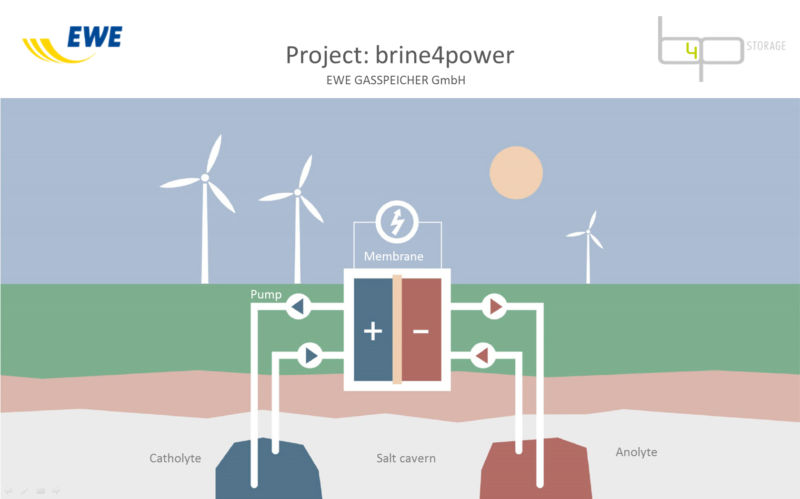
A German energy company recently announced that it’s partnering with a university to build a massive flow battery in underground salt caverns that are currently used to store natural gas. The grid-tied battery, the company says, would be able to power Berlin for an hour.
The technology that the project is based on should be familiar to Ars readers. Two years ago, Ars wrote about an academic paper published in Nature that described “a recipe for an affordable, safe, and scalable flow battery.” German researchers had developed better components for a large, stationary battery that used negatively and positively charged liquid electrolyte pools to exchange electrons through a reasonably priced membrane. These so-called “flow batteries” are particularly interesting for grid use—they have low energy-density, so they don’t work for portable energy storage. But as receptacles for utility-scale electricity storage, their capacity is limited only by the amount of space you have.Now the ideas in that paper are graduating to real-world use. EWE Gasspeicher, a gas-storage company owned by German power company EWE, announced in June that it’s looking into building the researchers’ flow battery in two medium-sized salt caverns that the company has been using to store natural gas. EWE is calling the project “brine4power,” reflecting how a saltwater brine is used in the electrolyte.
Ralf Riekenberg, head of the brine4power project, stated in a press release that EWE and the researchers “need to carry out some more tests and clarify several issues” before they start building. “However, I expect that we will have an operating cavern battery by about the end of 2023,” Rickenberg said.
So far, the researchers, who work at the Friedrich Schiller University in Jena, have only built a flow battery the size of a rain reclamation barrel. The project is scheduled to proceed in three phases: first, an above-ground, 10kWh to 40kWh test system will be built; then they'll build an above ground, 500 kWh to 2,500kWh test system; then, if all goes well and if the natural gas caverns are a good fit, a pilot battery in EWE’s salt caverns with a 120MW/750MWh capacity will be built. EWE claims its flow battery would be the biggest in the world.
But if construction lasts until 2023, EWE’s project likely won’t hold that title. Currently the largest containerized flow battery in the world is in Snohomish County, in Washington state. It’s a (relatively) petite 2MW, 8MWh vanadium redox flow battery that spans more than 20 connected shipping containers, built by UET. But UET’s sister company in China is currently building a flow battery outside of Dalian that is much, much bigger—that project is supposed to be 200MW/800MWh, with the first half finished by the end of 2018.
EWE’s salt cavern idea is made possible thanks to the materials that the Jena researchers put forward in their 2015 papers. Instead of using vanadium, which could pollute the environment if it seeps out of the ground, this project “uses recyclable polymers (plastics) dissolved in salt water as an electrolyte,” EWE says.
“In first tests, the redox-flow battery from Jena could withstand up to 10,000 charging cycles without losing a crucial amount of capacity,” the Jena researchers wrote of their battery. “The energy density of the system presented in the study is 10 watt-hours per liter.”
EWE’s salt caverns are on Germany’s northwestern coast in Jemgum, and “some are even so large they could fit Cologne Cathedral inside,” the company says.
With Germany pushing to put record amounts of wind and solar power on the grid (900MW of offshore wind in 2017 alone, Reuters reported today), storage projects have been equally ambitious. Earlier this year, German mine owner RAG AG announced a pumped storage plan that would be built in a soon-to-be-retired underground coal mine. And a German research institute has been working on a pilot project to build underwater energy-storage spheres that would pump water out during times of plentiful electricity and use water rushing inward to create hydroelectric power during times where electrical demand exceeds supply.
reader comments
66